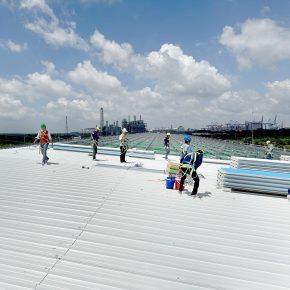Demystifying fire safety legislation for multiple occupied houses
The size, layout and occupants of a building are the most important considerations for anyone designing a fire detection system, and are usually the key indicators of which legislation the system must comply with.
BS 5839: Fire Detection and Fire Alarm Systems
BS 5839, for example, is the British Standard for Fire Detection and Fire Alarm Systems for Buildings and is mandatory for all building types. For multi-occupancy buildings up to and including two storeys BS 5839 Part 6 is the main code of practice, while Part 1 may also be relevant, particularly in large buildings and communal areas. For buildings with three of more storeys, both the individual units and communal areas are subject to Part 1.
BS 5839 also divides fire alarm systems into a number of categories, with exact categories a building should comply with determined by size and layout, as well as its potential risk level. For example, Part 6 recommends LD3 as the minimum category for existing buildings, which means detectors are installed in all circulation spaces that form part of the escape route, such as hallways, and LD2 as the minimum category for new buildings, which also includes rooms where fires are likely to start such as kitchens. If the building is classed as high risk for potential fires LD1 or LD2 will be the minimum requirement, regardless of whether the building is new or not.
As well as the system categories, BS 5839 Part 6 also defines a number of system grades, which refer to how comprehensive the level of fire detection technology is. There are six grades from A to F, with Grade A the most comprehensive and Grade F the most basic.
Approved Document B (ADB) Fire Safety guide
For recommendations on the relevant parts and categories of BS 5839 for HMOs, the Approved Document B (ADB) Fire Safety guide to the Building Regulations is a great starting point. The ADB is split into two volumes, with volume 1 providing guidance for dwelling houses and volume 2 dealing with non-dwelling houses, however it also includes guidance for flats. Both volumes provide specific recommendations on the relevant parts and categories based on building size and layout, again taking into consideration the impact of the buildings users and additional legislation that may be required.
In addition to BS 5839 and Approved Document B, certain HMOs will be subject to other regulations based on its occupants. If the building is used by disabled residents, for example, then it may be subject to the requirements of the Disability Discrimination Act (DDA). The DDA states that Visual Alarm Devices (VADs) must be fitted in properties likely to be used by disabled residents to maximise the likelihood of their being alerted to a safety incident.
Local authorities
Local authorities may also have their own regulations for fire safety systems. Since 2006 the licensing of HMOs with three of more storeys has been mandatory and some local authorities may also have chosen to broaden this out to include smaller HMOs. As a result there may additional or different local area regulations that your building is subject to. It is advisable to check this with the local housing authority.
On the surface, tackling legislation for fire systems in HMOs can seem complicated. However, a solid assessment of risk including the buildings occupants, size and layout is usually the best starting point. It is also always advisable to speak with an expert, whether that be a manufacturer or installer, to ensure that the chosen fire detection system will maximise the safety of the buildings’ occupants in the event of a fire.
Article by Julian Bailey, regional sales manager at Hochiki Europe. Hochiki design and manufacture innovative life safety solutions including commercial and industrial fire detection and emergency lighting.
Latest news

16th April 2024
Mitsubishi Electric set to host CIBSE Journal webinar
Mitsubishi Electric will host a CIBSE Journal webinar on Wednesday 24th April 2024 at 1pm to discuss the legislation and initiatives driving changes in the way we will need to heat, cool and ventilate large commercial buildings to reach net zero emissions in the UK.
Posted in Air Conditioning, Articles, Building Industry Events, Building Industry News, Building Products & Structures, Building Regulations & Accreditations, Building Services, Facility Management & Building Services, Heating Systems, Controls and Management, Heating, Ventilation and Air Conditioning - HVAC, Information Technology, Pipes & Fittings, Plumbing, Seminars, Sustainability & Energy Efficiency, Training
16th April 2024
Hamworthy: What to consider when choosing a heat pump?
At the heart of an efficient heat pump system lies an important element: the refrigerant – Jason Allen, Commercial Product Manager, Groupe Atlantic UK, ROI & NA. Hamworthy Heating is a Groupe Atlantic brand.
Posted in Articles, Building Industry News, Building Products & Structures, Building Services, Facility Management & Building Services, Heating Systems, Controls and Management, Heating, Ventilation and Air Conditioning - HVAC, Pipes & Fittings, Plumbing, Retrofit & Renovation, Sustainability & Energy Efficiency
15th April 2024
EJOT Colorfast chosen for Kingspan’s highly sustainable new Asian factory
More than 120,000 EJOT Colorfast self-drilling fasteners have helped Kingspan to create a thermally superior, visually-appealing building envelope for its first purpose-built manufacturing plant in South East Asia.
Posted in Articles, Building Industry News, Building Products & Structures, Building Systems, Case Studies, Posts, Restoration & Refurbishment, Retrofit & Renovation, Roofs, Sustainability & Energy Efficiency
15th April 2024
ASSA ABLOY helps new manufacturing plant achieve LEED Gold certification
Improving sustainability performance is becoming a higher priority for building developers, owners and users. One consequence is fast-growing demand for green building certifications — and therefore specification. Specialist input can make the difference between hitting and missing a project target, as ASSA ABLOY explains here…
Posted in Access Control & Door Entry Systems, Architectural Ironmongery, Articles, BIM, Infrastructure & CAD Software, Building Industry News, Building Products & Structures, Building Regulations & Accreditations, Building Services, Case Studies, Doors, Facility Management & Building Services, Information Technology, Retrofit & Renovation, Security and Fire Protection, Sustainability & Energy Efficiency
 Sign up:
Sign up: